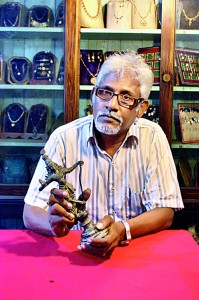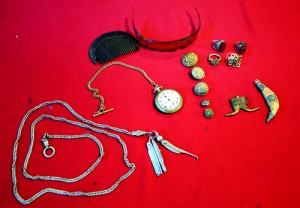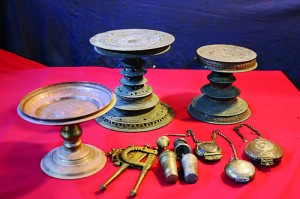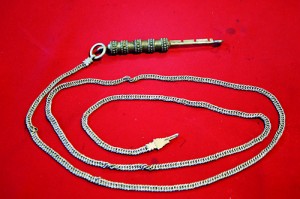Silver and gold in the gentleman’s attire of hundred years ago
Walk into Sudath Hewage’s antique shop tucked away on a bustling lane in Fort, Colombo and you will hear less sales talk but more history. Locked inside his old-fashioned glass cupboards is the story of sartorial habits and the opulence of the affluent Sri Lankan man of hundred years ago who Mr. Hewage says literally “shone in silver and gold.”

Exploring the past: Sudath Hewage
He wore gold sovereigns as buttons down his long coat, each of which was linked to a gold chain. He also wore bulging ornate buttons in silver and gold. Instead of the leather belt worn today, Mr. Hewage showed a thick silver “havadiya” (waist chain) which went round his tweed cloth, at times several rounds, to hold up the cloth securely. Not only a bunch of keys but he also had a cluster with an ear cleaner, tooth pick and a nail cleaner all in silver, dangling from his waist chain.
With wristwatches yet to appear on the scene, carrying a pocket watch in the upper pocket was a status symbol of the affluent.Producing a miniature watch, Mr. Hewage showed how it was fixed to the coat button with a silver or gold chain. He even had a few gold teeth among his set of teeth which glittered when he smiled. And he had not paid lesser attention to his head as a crescent-shaped comb or a “namipanawa,” made out of polished tortoise shell, sat on the crown of his head, above his knot. These were worn mostly by Muhandirams. The arachchi rank wore the thick, long toothed comb on their head.
“When tea-industry – the third wave of plantations after cinnamon and coffee, developed and expanded, investments of Sinhalese were already in place,” wrote reputed historian K.M. De Silva on “Impact of colonialism” in “The Sri Lanka Reader.” Sinhala capitalists however, were far more prominent in the rubber industry than in the tea plantations. And the production of coconut was almost a monopoly of Sinhala plantation owners and small holders, while they played the predominant role in the mining and export of graphite. The share of the Sinhalese in the general commercial (“modern”) sector of the economy by this time was significant and one of the most notable of this was the emergence of a considerable class of indigenous “capitalists.”
For this generation of “capitalists,” westernising and westernised culture under the colonial rule was a social advantage and some of them were found blindly imitating the colonial masters. They took western names and surnames, followed western habits of eating and wore the western dress.

From a gentleman’s wardrobe: The ‘havadiya’, pocket watch, buttons and ‘namipanawa’. Pix by Athula Devapriya
The English-speaking upper classes, who identified themselves as westerners, wore western suits, top hats and tail coats. A.V. Suraweera, who was professor of Sinhala at the Jayawardenepura University, writing on the topic of “Modern Sinhala fiction and social change in Sri Lanka” focused on these middle class capitalists. During the late British period, the capitalists, he stated, imitated the British to such an extent that some of them wore trousers underneath their tweed cloth. Quoting from Martin Wickremasinghe’s “Yuganthaya,” he said that the description of Aravinda’s parents’ wedding photograph gave an indication of how the well-to-do people dressed in the first few decades of the last century. “The bridegroom wore a tweed cloth over a pair of trousers and coat stretching up to the knees with tie, socks and shoes. The hair was tied in a knot and on the teapoy was a black hat.”
The attire which was common at the time among the middle class, prompted cynics to coin the term “redda asse mahattaya” (gentleman under the cloth) and led nationalists and writers such as Piyadasa Sirisena (1906) to take on these imitators of the west. Their campaigns were effective as this generation gradually ceased to exist.
Martin Wickremasinghe’s “Gam Peraliya” gives a panoramic view of this social transformation where “Piyal” from the village, is

A favourite pastime: The betel-chew implements- mini betel-chopper, betel stand, ornamental nutcracker, the ‘killotaya’ for chunam and the stand on which meals were placed when having them outside homes
symbolic of achieving prosperity in the commercial sector and being influenced by the west. The degree of western influence however, differed according to social groups, religion, the locality and probably the southern coastal strip according to Wickremasinghe and the city of Colombo received the greater impact on social life.
This new “westernised capitalists” didn’t ask for political changes and had no specific desire to change the existed order of society. Instead, they lived it up, leading a life of opulence.
Mr. Hewage, who regaled us about the expensive life-style of this entrepreneurial class says that they, may have spent long hours at the writing bureau where with no computer, calculator or telephone, they made it in life. With spectacles yet to appear, they used a monocle in one hand for reading and writing and Mr. Hewage produced an old ink stand which had been well used with two bowls for red and blue ink, a pen with nib and a calendar at its centre. In his possession was also a mini decorative pill box made with buffalo horn which some of the entrepreneurs may have carried with them with their medicinal “guli”. The antique combination lock, which would have been used to keep his valuables safe, is a collector’s item. A tiny decorative tube, indeed an ingenious device which had been crafted long before combination locks arrived in Sri Lanka,comes in three parts and needs to be turned till a straight line forms for it to be unlocked.

Before the belt: The waistchain that went round the tweed cloth
An old cylindrical cigarette container, with a holder to place the box of matches and a decorative silver ash tray, indicates the prevalence of the smoking habit at the time. What however is well in evidence from the array of antique pieces he has in his collectionis the fact that betel-chewing had been a national pastime. Among Mr. Hewage’s precious collection is a tiny silver betel-pounder, the size of the palm, which could be easily slipped into the coat pocket. It opens on one side for betel, arecanut, chunam etc. to be inserted and the user needs only to push up and down the tiny pestle within it to have a well-chopped betel-mix to enjoy.
The elaborately decorative betel-trays (bulathheppuwa,) the nut cracker (giraya,) the chunnam or the lime box (killotaya) as well as the serakkalaya, the spiralled and double spiralled brass stand on which was served meals on the leaf dish are objects which had been well used once. Some of these, as signatures on them indicate, had been exclusively crafted on specifications of fastidious individuals to indulge in their favourite habits as they fancied.


